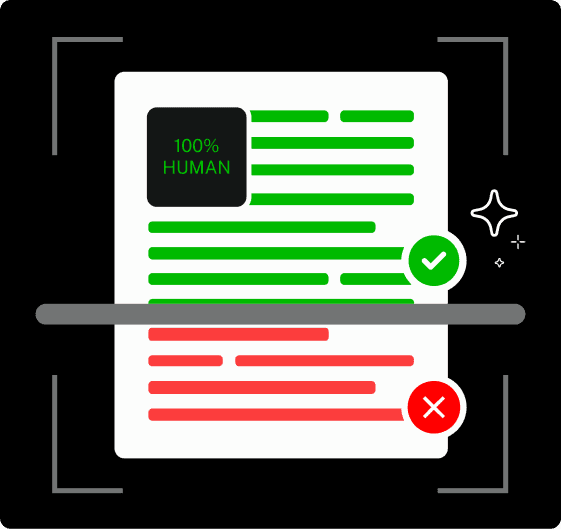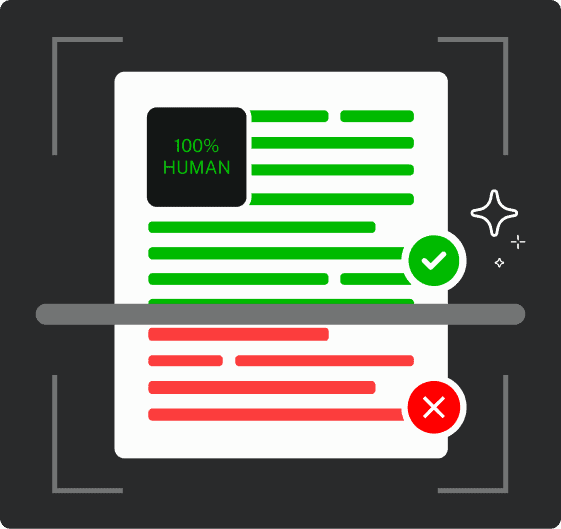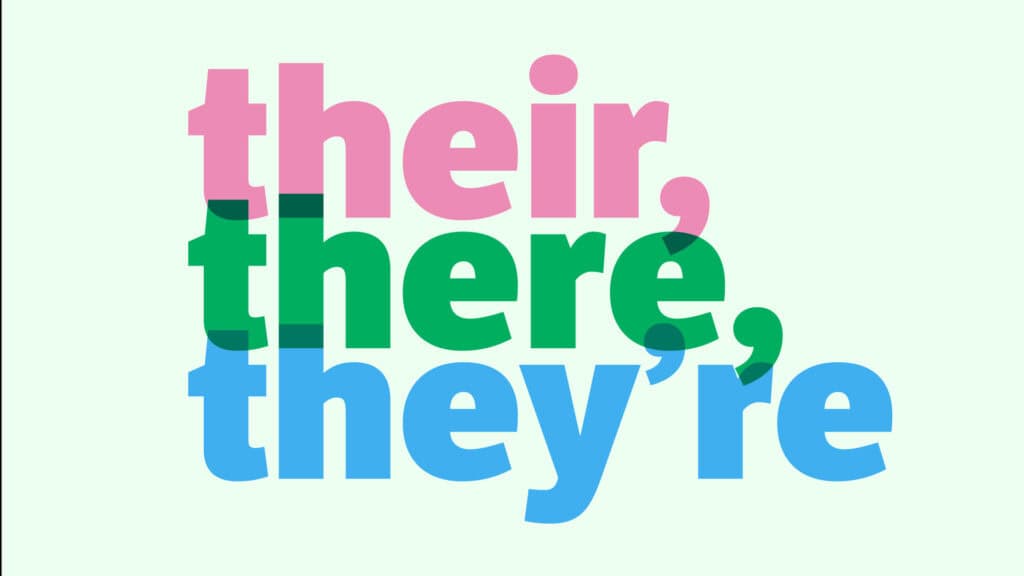There, their and they’re: the holy trinity of the most common grammar mistakes.
Together, they’re the inspiration for many memes, prime examples for grammar buffs, and the source of frustration for less ___ savvy ____.
If you want to brush up on your grammar and learn how to differentiate these three words, this guide breaks down these commonly confused words with simple explanations (with practical examples).
In the end, you’ll have no trouble using the right word every time.
Why People Mix Up There, Their, and They’re
Why do so many people—even native English speakers—struggle to differentiate between these three words?
The confusion stems from a perfect storm of linguistic challenges:
- They sound identical when spoken (they’re homophones)
- They look similar on the page (differing by just a few letters)
- They appear frequently in everyday writing
- Autocorrect doesn’t always catch these types of errors
Our brains process spoken language differently than written language.


Never Worry About AI Detecting Your Texts Again. Undetectable AI Can Help You:
- Make your AI assisted writing appear human-like.
- Bypass all major AI detection tools with just one click.
- Use AI safely and confidently in school and work.
When we speak, we don’t need to distinguish between these homophones as the context makes the meaning clear.
But when writing, we suddenly need to apply a different rule for each version.
Add to this the fact that many of us type quickly, letting our muscle memory take over.
We might know the difference intellectually but still type the wrong word out of habit.
Let’s break down each word to end this confusion once and for all.
What Does “There” Mean?
“There” is probably the most versatile of the three homophones.
It serves several important functions in English:
- It indicates location (physical or metaphorical)
- It can start sentences as an introducer
- It appears in certain expressions and idioms
When referring to a place or position, “there” is the word you need. Think of “there” as answering the question “where?”
Examples of “there” indicating location:
- Put the book over there.
- I’ve never been there before.
- The answer is right there in the text.
“There” also commonly starts sentences when introducing something:
- There is a solution to this problem.
- There are many ways to learn grammar.
- There seems to be a misunderstanding.
A simple way to remember its meaning: “There” contains the word “here” within it—and both words relate to location.
What Does “Their” Mean?
“Their” is a possessive pronoun that shows ownership or belonging.
It’s similar to other possessive pronouns like “my,” “your,” “his,” and “her.” The key difference is that “their” indicates that something belongs to “them” (multiple people or things).
When you need to show that something belongs to or is associated with a group, “their” is your word.
Examples of “their” showing possession:
- The students finished their assignments.
- The dogs wagged their tails excitedly.
- People should be careful with their personal information.
“Their” is also increasingly used as a singular pronoun for a person whose gender is unknown or for someone who doesn’t identify with binary gender categories:
- Someone left their umbrella in the office.
- Each student should submit their paper by Friday.
A memory trick: “Their” contains the word “heir”—and heirs inherit possessions. Both relate to ownership.

Source Dictionary.com
What Does “They’re” Mean?
“They’re” is the simplest of the three to define but perhaps the easiest to misuse when writing quickly.
“They’re” is a contraction—a shortened form of two words: “they” and “are.”
Whenever you can replace the word with “they are,” and the sentence still makes sense, “they’re” is correct.
Examples of “they’re” as a contraction:
- They’re going to the concert tonight.
- I think they’re working on the project now.
- They’re the best team in the league.
The apostrophe in “they’re” indicates that letters have been removed to combine the two words.
This is the same pattern used in other contractions like “don’t” (do not), “isn’t” (is not), and “we’re” (we are).
A quick test: If you can substitute “they are” in your sentence and it still makes sense, then “they’re” is the correct choice.
Examples of Each in Sentences
Let’s see these three words in action with more examples to solidify your understanding.
There:
- There goes the bus we need to catch.
- Is there any coffee left?
- The restaurant is just over there, across the street.
- There aren’t enough chairs for everyone.
- I stopped reading there because it got boring.
Their:
- Their house is on the corner.
- The team celebrated their victory with a party.
- Students must submit their assignments by midnight.
- The cats licked their paws after dinner.
- Their argument makes no sense to me.
They’re:
- They’re planning to visit next week.
- I heard they’re reopening the old theater.
- They’re the most experienced developers on the team.
- If they’re late again, we’ll start without them.
- I don’t think they’re aware of the changes.
Tricks to Remember the Difference
Remembering the correct usage doesn’t have to be difficult.
Here are some tricks that can help you choose the right word every time:
- The Location Test: If you’re referring to a place or starting a sentence with an introducer, you need “there.”
- Try substituting “here” to see if it’s talking about location.
- The Possession Test: If you’re showing ownership or belonging, you need “their.”
- Ask yourself: “Who does this belong to?” If the answer is “them,” use “their.”
- The Substitution Test: For “they’re,” simply try replacing it with “they are” in your sentence.
- If “they are” works in context, then “they’re” is correct.
- Visual Memory Aids:
- “There” has “here” in it (both location words)
- “Their” has “heir” in it (both about possession)
- “They’re” has an apostrophe replacing the missing ‘a’ from “they are”
Practicing these tests will soon make the correct choice automatic.
Common Mistakes and How to Avoid Them
Even when we know the rules, these words continue to trip us up.
Here are the most common mistakes people make and strategies to avoid them:
- Mistake 1: Using “their” for locations
❌ The book is on their table. (When “there” is meant as a location)
✓ The book is over there on the table.
- Mistake 2: Using “there” to show possession
❌ There car broke down. (When talking about someone’s car)
✓ Their car broke down.
- Mistake 3: Using “their” instead of a contraction
❌ Their going to be late. (When meaning “they are”)
✓ They’re going to be late.
- Mistake 4: Using “they’re” for possession
❌ They’re books are on the shelf. (When talking about books belonging to them)
✓ Their books are on the shelf.
- Mistake 5: Using “there’s” when talking about multiple items
❌ There’s many reasons to learn this rule. (Incorrect because “reasons” is plural)
✓ There are many reasons to learn this rule.
The key to avoiding these errors is to slow down when writing and quickly ask yourself which word you need based on the context.
How to Never Get It Wrong Again
If you want to eliminate these errors from your writing permanently, here are some proven strategies:
- Proofread specifically for these words. Do a search for “there,” “their,” and “they’re” in your document and check each one individually. This also works for other tricky homonyms like “your” and “you’re,” which often get swapped in casual writing.
- Read your writing aloud. Hearing your sentences can make awkward phrasing and word misuse—especially with sound-alike words—much easier to catch.
- Use a grammar checker. Most writing software includes built-in tools that flag obvious mistakes, but they aren’t always reliable with context-sensitive homonyms like these.
- Create personal examples. Come up with short, memorable sentences that use each word correctly. Keep them visible on your desk or notes app for quick reference.
- Practice deliberately. Spend just five minutes a day writing sentences that use all three correctly. Repetition is the fastest way to lock in muscle memory.
- Tap into Undetectable AI’s AI Chat tool. For a smarter, more intuitive grammar assistant, Undetectable AI’s AI Chat goes beyond generic grammar checkers.

You can type or paste your sentence into the chat and ask if you’ve used the correct form—“Is this the right ‘their’?” or “Did I use ‘you’re’ correctly here?”—and the tool will not only confirm the answer but also explain why.
It’s designed to handle common homonym confusion by giving context-aware feedback, helping you avoid mistakes not just now but for good.
It’s like having a real-time editor who never sleeps.
Even professional writers and editors make these mistakes occasionally.
The difference is that they’ve built systems (like this one) to catch and correct those slips before anyone else sees them.
Test our AI Detector and Humanizer now using the widget below!
FAQs About There, Their, and They’re
Are there grammar rules that explain the difference?
Yes. There refers to a place or introduces a sentence. Their shows possession.
They’re is short for “they are.” Each serves a different grammatical purpose.
Why is “they’re” so confusing?
It sounds the same as “there” and “their,” making it easy to mix up—especially when typing fast, skipping apostrophes, or relying on autocorrect.
It’s a classic case of homophones causing trouble.
Is it okay to mess this up in casual writing?
In texts or DMs? Probably. But in emails, essays, or anything professional, using the wrong one can hurt your credibility.
People do notice—even if they don’t call it out.
There, Their, They’re… Handled
Mastering the difference between “there,” “their,” and “they’re” is a small change that can significantly improve your writing.
These three words might sound the same, but they serve entirely different grammatical functions:
- There: Indicates location or introduces a clause
- Their: Shows possession or belonging
- They’re: Contracts “they” and “are”
Brushing up on these distinctions and applying the simple tests we’ve discussed can help eliminate this common error from your writing permanently.
And if you ever second-guess yourself, tools like Undetectable AI’s AI Chat can help.
It’s a real-time grammar assistant that explains why a word is right or wrong, helping you build confidence as you write.
Remember that everyone makes grammar mistakes occasionally. The goal isn’t perfection but improvement.
Each time you pause to consider which word is correct, you’re strengthening your writing skills.
Practice makes perfect, so there’s no better time than now to master their proper usage. They’re worth the effort!
